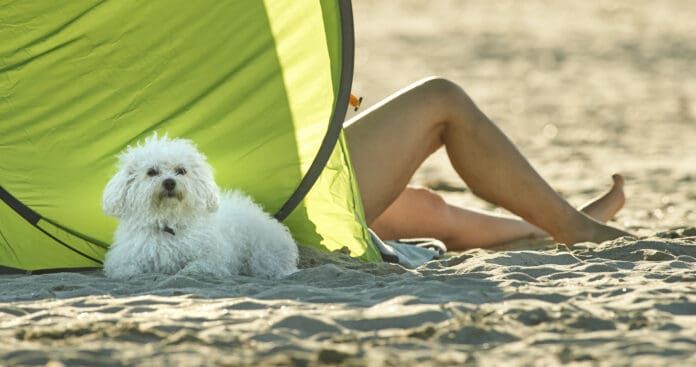The first signs of heat exhaustion in dogs are easy to miss, like the dog who normally plays fetch for at least 10 throws but slows down after five. He’s panting, but it isn’t the usual happy and excited pant you’re familiar with. It’s more intense and heavier than usual. If your dog is panting heavily, he needs to cool down.
Your dog’s tongue can be key to detecting increasing heat stress. If your dog is panting and his tongue looks abnormally long and wide, and/or his lips are pulled back to expose more of his gums and oral tissues, he is trying to maximize his evaporative cooling process through his mouth. His drool may look thick, and his mucous membranes may be bright red. All this adds up to a dog working hard to cool off.
Signs of Heat Exhaustion in Dogs
A dog moving into an emergency level of heat exhaustion, called heat stroke, may appear weak and even stumble. This dog needs immediate veterinary care. You may also notice:
- Muscle tremors and weakness
- Increased heavy panting
- Increased thirst but nose/mouth dry
- Vomiting
- Diarrhea
- Elevated pulse (check in the groin area)
- Abnormal gum color
- Increasing dehydration
Check for dehydration by gently pulling up a small amount of skin.If the skin “tents up” when you squeeze it and doesn’t immediately slip right back into place, the dog is dehydrated. If your dog’s mouth is dry or his saliva is thick, flush his mouth with cool water and encourage him to drink.
We all know children and dogs can die if left in a hot car and, sadly, stories abound about people who still do this. Some vehicles now allow you to lock the car and leave it running, which may tempt you to leave your dogs in the car. Don’t do it.
Literally, as I write this article, I read about a heat-related dog tragedy at a dog event in the Northeast. The owner parked her car in the shade and left it running with the air conditioning on. She did checks every 30 to 40 minutes. On her last check, the car was still running but the AC had quit. Three dogs were dead, one was seizuring, and three were in critical condition.
In another incident earlier this year, dogs were left in an RV with air conditioning running and a temperature monitor in the RV. Sadly, both the AC and monitor malfunctioned, and the dogs died. Don’t leave your dogs unattended.
As the heat exhaustion worsens and the body temperature elevates, the dog’s gums change from bright red to pale. The dog begins hyperventilation. His blood pressure will drop, and he may become unconscious, collapse, or go into seizures. With high enough body temperatures (such as 107 degrees F), organ failure sets in. Put your dog in the car, blast the AC, and get him to a veterinarian immediately.
What To Do for Heat Stress in a Dog
If your dog is panting excessively or collapses, get him cool! Putting him in a tub of cool water is ideal. If not, pour cool water or run a hose over him, targeting thin-haired areas like the “arm pits” and the groin area (just hosing off his back is inefficient, especially if he has a thick coat, because the water just rolls off the coat and doesn’t quickly get down to the skin).
If you can monitor temperatures, try to get him down to 104. Add fans once he is in your car and turn up the AC, letting it blow on him.
Dogs cool off through evaporative cooling, although they do sweat a bit through their foot pads. Evaporative cooling occurs via panting, so your dog must be well-hydrated to get the full benefit of the panting. A dog’s body will also shift blood flow to surface areas, using vasodilation to help cool things off—so, for example, you might notice your dog’s ears being very red.
How to Keep a Dog from Overheating

Clearly, prevention is the best way to minimize heat stress and avoid heat stroke. To do this:
- Limit play and training during hot weather.
- Stick to shaded, grassy areas if possible, including for rest.
- Always have fresh, cool water available in the shade and add ice cubes.
- If your dog is working, consider using cool treats, such as frozen-low sodium bouillon, doggy ice cream, or watermelon.
- Provide a kiddie pool (be sure water is fresh and cool), splash pad, or misting water sprinkler.
- Make your dog take a periodic break from playing.
If you are hiking, choose trails that are shaded and not too strenuous. Let your dog wade in a running creek. Caution: Avoid stagnant bodies of water as algae buildups can be toxic. Be sure you have drinking water for your dog (and you!) with you.
Dogs at High Risk for Heat Exhaustion
With dogs at high risk for heat stress include older dogs, overweight dogs, and brachycephalic dogs (the ones with short faces and muzzles), it is best to leave them safely at home. If that’s not possible, someone should always be with them.
Some dog-sports competitors use dog cool coats to help protect the dog from the intense rays of the sun. These are coats that can be wetted down and reflect the sun.
When I travel with my dogs in the summer, I leave my car open (minivan), with open weave shade cloths covering it, and fans on when I am parked. I park in shade if possible and orient my car to catch any breeze. I have extra fans and batteries. I stay with my dogs as much as possible.
Use drive-ups to get food and drinks instead of going into a restaurant. When purchasing gas, pull your car up so it is in shade.
So far, I have not had problems, but if it is truly hot, we stay home. Heat-related problems are serious. Even dogs who seem fine may show signs of organ damage a few days later. This is a health problem to avoid.





